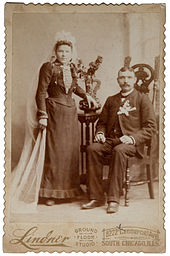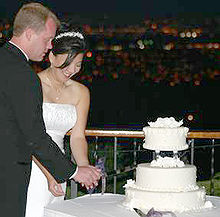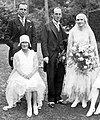Custom of 1870 Brides to Wear Their Wedding Dress Again During First Year of Marriage
A white nuptials is a traditional formal or semi-formal wedding ceremony originating in Smashing Britain.
The term originates from the white colour of the hymeneals wearing apparel, which first became popular with Victorian era elites after Queen Victoria wore a white lace dress at her wedding.[one] The term now besides encapsulates the entire Western wedding routine, especially in the Christian religious tradition,[2] which generally includes a church building service during which the union begins, followed by a reception. The white wedding ceremony fashion was given some other significant heave in 1981, when three-quarter billion people—one out of half dozen people effectually the earth—watched Charles, Prince of Wales ally Diana Spencer in her elaborate white taffeta dress with a 25-foot-long train.[3] This wedding is by and large considered the virtually influential white wedding of the 20th century.[3]
History of the white clothes [edit]

A bride from the late 19th century wearing a black or dark coloured wedding dress
Though Mary, Queen of Scots, wore a white wedding gown in 1559 when she married her starting time husband, Francis Dauphin of French republic, the tradition of a white wedding wearing apparel is ordinarily credited to Queen Victoria's choice to wear a white court dress at her wedding to Prince Albert in 1840.[four] [v] Debutantes had long been required to wearable white court dresses and long white gloves for their commencement presentation at court, at a "Drawing Room" where they were introduced to the queen for the first fourth dimension.[iv]

Queen Victoria and Prince Albert on their render from the marriage service at St James'south Palace, London, 10 February 1840.
Royal brides before Victoria did not typically wear white, instead choosing "heavy brocaded gowns embroidered with white and silver thread," with red being a especially popular colour in Western Europe more generally.[4] During this time, European and American brides wore a plethora of colours, including bluish, xanthous, and practical colours like black, brown, or greyness. As accounts of Victoria'south wedding spread across the Atlantic and throughout Europe, elites followed her pb.
Because of the limitations of laundering techniques before the later part of the 20th century, white dresses provided an opportunity for conspicuous consumption. They were favored primarily every bit a way to show the globe that the bride'due south family was and so wealthy and so firmly part of the leisure class that the helpmate would cull an elaborate dress that could be ruined past whatever sort of work or spill.[3] [six]
Although women were required to wearable veils in many churches through at least the 19th century, the resurgence of the wedding veil as a symbol of the bride, and its use even when non required past the helpmate'southward religion, coincided with societal emphasis on women being modest and well-behaved.[iii]
Etiquette books so began to turn the practice into a tradition and the white gown before long became a popular symbol of status that also carried "a connotation of innocence and virginal purity."[v] The story put out most the hymeneals veil was that decorous brides were naturally too timid to show their faces in public until they were married.
By the finish of the 19th century the white dress was the garment of choice for elite brides on both sides of the Atlantic. However, middle-class British and American brides did not adopt the tendency fully until afterward World War II.[seven] With increased prosperity in the 20th century, the tradition also grew to include the practise of wearing the dress only once. As historian Vicky Howard writes, "[i]f a helpmate wore white in the nineteenth century, it was acceptable and probable that she wore her gown again".[5] Even Queen Victoria had her famous lace wedding dress re-styled for later use.[3]
The portrayal of weddings in Hollywood movies, particularly immediately afterwards World War 2, helped crystallize and homogenize the white wedding into a normative form.[8]
Other traditions [edit]

A bride in a gimmicky white wedding dress with train, tiara and white veil, taken in 2003.
"Color Cycle Pro" describes[9] white in clan with light, goodness, innocence, purity and virginity. White is too often considered to be the colour of perfection.[2] As for other significant meanings for white on a wedding day, "colormeaning.com" says, "In color psychology, white is the color of new ancestry — wiping the slate clean. The color white is a blank canvas, just waiting to be written on."[x] White is the color in Western culture about oft associated with beginnings. Christ after the Resurrection is traditionally portrayed dressed in white. In Christianity, children are baptized and beginning take communion wearing white. Baptisms are peculiarly tied to white since the person is making a religious commitment to be pure and clean before God. Religious rites and the clothing associated with them have e'er been of import, and white is often a common color used to express high religious delivery and purity.[2] In 2018, about 83% of brides in the Usa wore white dresses on their big 24-hour interval, co-ordinate to a survey by Brides Magazine.[eleven] , For weddings in the temples of The Church of Jesus Christ of Latter-day Saints, white clothing is worn by both the helpmate and the groom during the ceremony.[12] [13]
The traditional white wedding was not necessarily divers by the colour of the dress but. The wedding of Queen Victoria's daughter Victoria, to Prince Fredrick William of Prussia in 1858 also introduced choral music to the processional when standard practice had been to take music of any kind only during a party after the wedding ceremony ceremony.[14]
Afterwards World State of war I, equally full-scale formal weddings began to exist desired by the mothers of brides who did non accept a permanent social secretary, the position of the wedding planner, who could coordinate the printer, florist, caterer, and seamstress, began to assume importance. The start edition of Helpmate's Mag was published in 1934 as a newspaper advertising insert called "So Yous're Going to Get Married!" in a column titled "To the Bride", and its rival Mod Bride began publishing in 1949.
The full white wedding experience today typically requires the family unit to arrange for or buy printed or engraved nuptials invitations, musicians, decorations such as flowers or candles, dress and flowers for bridesmaids, groomsmen, a flower girl, and a band bearer. They may also add optional features, such as a guest volume or commemorative wedding leaflets. It is common to have a celebration after the wedding ceremony, commonly featuring a large white wedding cake.
Participants [edit]
Traditional weddings require, in addition to the helpmate and groom, a marriage officiant, which is a minister, priest, rabbi, imam, or civil officeholder who is authorized to perform marriages.
Typical white weddings besides include a hymeneals party, which consists of some or all of the following:
- Groomsmen or ushers: I or more friends or family members who assistance the groom, normally men. The chief groomsman is called the best man, and is given a identify of accolade. A woman (such as the sister of the groom) is called an honor attendant.
- Bridesmaids: 1 or more friends or family unit members who support the bride. The primary bridesmaid may exist called a maid of honor or matron of honor. A daughter too young to exist marriageable, but too sometime to be a flower girl, is chosen a junior bridesmaid.
- Flower girl: A young girl who scatters flowers in front of the conjugal party.
- Ring bearer: An attendant, oftentimes a young boy, who carries the wedding rings.
Typically, these positions are filled by close friends of the bride and groom; beingness asked to serve in these capacities is seen as an honor, and typically entails some expense.
The ceremony [edit]

A Lutheran priest in Federal republic of germany marries a young couple at the church.

When the guests get in for a wedding, the ushers, if any, aid the guests take their places. In a typical white wedding ceremony ceremony, which is derived primarily from the Christian tradition (inclusive of denominations such equally Lutheranism and Anglicanism, for instance), the bride and groom volition stand side by side at the front of the church before the chancel throughout nearly or all the ceremony. Consequently, some guests prefer to sit down on the side closer to the person they know all-time. Typically, this means that the bride's family unit sits on the business firm left and the groom's family on house right. The front end rows are more often than not reserved for shut family members or friends.
Some couples make a ceremony of having their grandparents, step-parents, and parents escorted to their seats immediately earlier the wedding procession begins. In other cases, these relatives class part of the wedding procession.
Depending on the country, her historic period and situation, and her personal preferences, the helpmate may walk lone or exist escorted by her begetter, both of her parents, ane or more than relatives she wishes to honor, or the groom. In Swedish white weddings, the bride and groom usually go down the aisle together.[xv] Similarly, some couples choose to accept the groom escorted to the altar by his family.
Whether the helpmate is the offset or the concluding of the wedding party to enter the church varies by country. In the U.s., the bride is typically last, beingness preceded by the residual of the wedding party. In the UK, she leads the procession, followed by any bridesmaids, flower girls and page boys. Sometimes the groom is already present in the church; other times, he and whatsoever groomsmen course part of the procession. The music played during this procession is commonly called a wedding march, no matter what songs are played.
If the wedding is part of a religious service, then technically the service begins afterward the inflow of the participants, commonly with a prayer, blessing, or ritual greeting. During the ceremony, each partner in the couple makes marriage vows to the other in front of the union officiant. The ceremony might include the playing of a prelude, the singing of hymns, and Bible readings, too equally Holy Communion in accordance with the Christian matrimony liturgy of the church at which the nuptials is held, e.g. Lutheran, Catholic, Presbyterian, Anglican, Methodist, etc.[16]
Later the wedding anniversary itself ends, the bride, groom, officiant, and ii witnesses generally go off to a side room to sign the wedding register in the Great britain or the state-issued union license in the United states of america. Without the signing of the register or the marriage license, a marriage has not legally occurred.
Afterward, guests may cheer the deviation of the couple from the church by throwing blossom petals, confetti, birdseed, or rice over them. Miniature containers of bubbles are oft provided to guest to accident at the couple instead of throwing the previously mentioned items.
The reception [edit]

After this, the celebrations shift to a reception at which the newly married couple, as the guests of honor, and the hosts and mayhap members of the hymeneals party greet the guests in a receiving line. Although at present commonly called a reception no matter the mode of party, wedding celebrations range from unproblematic receptions to dinner parties to grand wedding assurance.
Food is served, particularly including a wedding cake. Nuptials cakes are often multi-tiered layer cakes that are elaborately decorated with white icing. Cut the wedding cake is oft turned into a ritual, consummate with sharing a symbolic bite of the cake in a rite that harks back to the pagan confarreatio weddings in ancient Rome.[17]
During the reception, a number of short speeches and/or toasts may be given in award of the couple.
If there is dancing, the bride and groom, as the guests of laurels, are expected to be the first people to begin dancing. This is usually termed the bridal waltz, even if the couple has arranged for a different mode of music. In Denmark, information technology is yet normal to dance the first dance every bit a couple to flit. Some families then contrive a series of arranged dances betwixt the newlyweds and their parents, or other members of the wedding ceremony party, with guests expected to watch the performances.
At some signal, the married couple may become the object of a charivari, a good-natured hazing of the newly married couple. The nature depends upon the circumstances. In Bharat and other S Asian cultures, guests may try to steal the groom's shoes when he removes them for a religious ceremony and afterward sell them back to him. This game is sometimes called joota chupai. In Western cultures, guests might tie can cans or a sign saying "Simply Married" to the bumper of the couple's car, if they depart in their own automobile rather than a hired one.
As the guests of honor, the newly married couple is the first to leave the political party. From ancient Rome through the Middle Ages in Europe, wheat kernels were thrown at the bride in a wish for affluence; now information technology is typical to throw rice, as a symbol of fertility, at the couple as they depart.[17]
Gallery [edit]
Photographs from late 19th century, early on 20th century, and early on 21st century weddings. The first ii images evidence the bride in a black or dark clothes. The photographic styles of capturing weddings continues to evolve from posed somber expressions to aboveboard moments showing emotion and joy.
-

Belatedly 1800s
-

A wedding party from the 1870s or 1880s
-

1929 wedding
-

-

-

-

-

1942 hymeneals
Meet as well [edit]
- Wedding ceremony dress of Queen Victoria
- Wedding dress of Lady Diana Spencer
- Blackness wedding
References [edit]
- ^ "Why Do Brides Wearable White?". britannica.com . Retrieved 7 September 2021.
- ^ a b c "5 special occasions when you should wear white". deseret.com. two December 2018.
- ^ a b c d e Ingrassia, Catherine (2007). "Diana, Martha and Me". In Curran, Colleen (ed.). Altared: Bridezillas, Bewilderment, Big Love, Breakups, and What Women Actually Think about Contemporary Weddings. New York: Vintage Books. pp. 24–30. ISBN0-307-27763-1.
- ^ a b c Otnes, Cele & Pleck, Elizabeth (2003). Cinderella Dreams: the Allure of the Lavish Wedding . Berkeley: University of California Press. p. 31.
- ^ a b c Howard, Vicky (2006). Brides Inc.: American Weddings and the Business concern of Tradition. Philadelphia: Academy of Pennsylvania Press. pp. 157–159.
- ^ Ramshaw, Gail (half dozen September 2004). Words around the Font. Wipf and Stock Publishers. p. 111. ISBN9781592449255. [1]
- ^ Jellison, Katherine (2008). It's Our Day: America'south Love Affair with the White Wedding, 1945–2005. Lawrence: University Printing of Kansas. pp. 65–67.
- ^ Martin, Judith (2005). Miss Manners' Guide to Excruciatingly Right Behavior. New York: Norton. ISBN0-393-05874-3. [ folio needed ]
- ^ "Color Meaning". color-bicycle-pro.com . Retrieved 7 September 2021.
- ^ "White Color Significant: The Color White Symbolizes Purity and Innocence". colour-meanings.com . Retrieved 7 September 2021.
- ^ "Why do brides wearable white?". theconversation.com. 4 September 2020.
- ^ "Lesson 5: Learning from the Lord through Symbols". Endowed from on High: Temple Preparation Seminar Teacher's Transmission. The Church building of Jesus Christ of Latter-day Saints. Retrieved 16 December 2021.
- ^ "Why Symbols?". Ensign. The Church of Jesus Christ of Latter-day Saints. February 2007. Retrieved xvi December 2021.
- ^ Pleck, Elisabeth (2000). Celebrating the Family: Ethnicity, Consumer Culture and Family Rituals . Cambridge, MA: Harvard University Press. p. 212.
- ^ "Vigselakten" [The Wedding Anniversary]. brollopstorget.se. Retrieved 22 March 2010.
Det vanligaste nuförtiden i Sverige är att brud och brudgum går in i kyrkan tillsammans.
- ^ Jr., Charles Yrigoyen; Warrick, Susan E. (vii November 2013). Historical Lexicon of Methodism. Scarecrow Press. p. 236. ISBN978-0-8108-7894-5.
In Methodism, the sacred service celebrates a covenenat grounded in the will of God and sustained by divine grace. ... Methodism encourages the solemnization of marriages inside the context of congregational worship and eucharistic commemoration.
- ^ a b Chisholm, Hugh, ed. (1911). "Bride". Encyclopædia Britannica. Vol. 4 (11th ed.). Cambridge Academy Press. p. 528.
External links [edit]
- Neil Shister, "Queen for a Day... a skeptical look at the modern hymeneals ritual" from Boston Review, Oct/November 1998
Source: https://en.wikipedia.org/wiki/White_wedding
Post a Comment for "Custom of 1870 Brides to Wear Their Wedding Dress Again During First Year of Marriage"